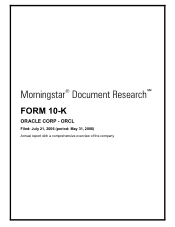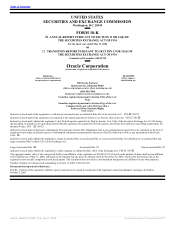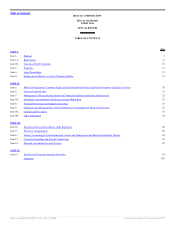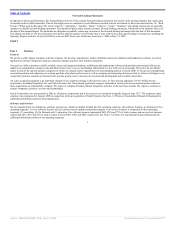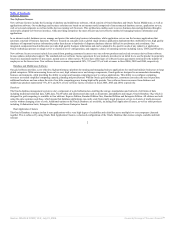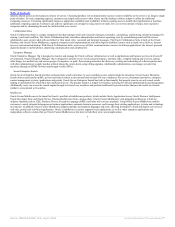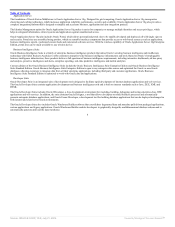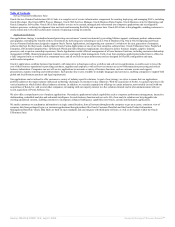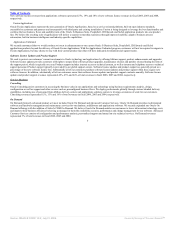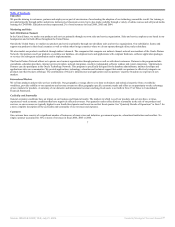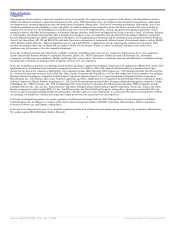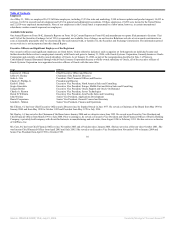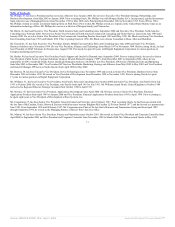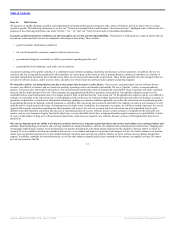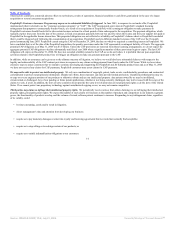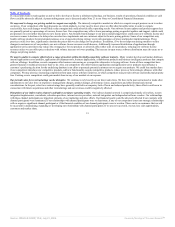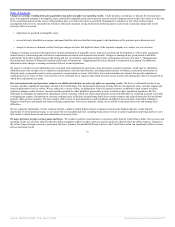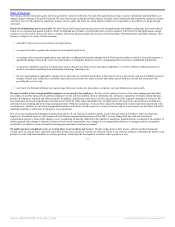Oracle 2005 Annual Report Download - page 11
Download and view the complete annual report
Please find page 11 of the 2005 Oracle annual report below. You can navigate through the pages in the report by either clicking on the pages listed below, or by using the keyword search tool below to find specific information within the annual report.
Table of Contents
Competition
The enterprise software industry is intensely competitive and evolving rapidly. We compete in various segments of this industry including database software,
middleware (business intelligence, application integration, portal server, J2EE application server, development tools and identity management), collaboration,
development tools, enterprise applications and consulting/systems integration, among others. Total cost of ownership, performance, functionality, ease of use,
standards-compliance, product reliability, security and quality of technical support are key competitive factors that face us in each of the areas in which we
compete. Our customers are also demanding less complexity and lower cost in the implementation, sourcing, integration and ongoing maintenance of their
enterprise software, which has led increasingly to our product offerings (database, middleware and applications) being viewed as a “stack” of software designed
to work together. Our product sales (and the relative strength of our products versus our competitors) are also affected by the broader “platform” competition
between industry-standard Java (J2EE) and Microsoft Corporation’s .NET programming environments and by operating system competition between Windows
Server, Unix (Sun Solaris, HP-UX and IBM AIX) and Linux. Open source alternatives to commercial software in many of our primary markets, such as MySQL
AB in database and Red Hat, Inc. / JBoss in application servers, and SugarCRM Inc. in applications are also impacting the competitive environment. These
products are typically offered free of charge and are readily available over the Internet. Finally, so-called “on demand” offerings, such as those from
salesforce.com, will continue to alter the competitive landscape.
In the sale of database software and related tools, scalability, reliability, availability and security are key competitive differentiators for us. Our competitors
include International Business Machines Corporation, Microsoft, Sybase, Inc., NCR Corporation’s Teradata division, SAS Institute, Inc., Informatica
Corporation, and the open source databases, MySQL and PostgreSQL, among others. Our ability to continually innovate and differentiate our database offering
has enabled us to maintain our leading position in database software over our competitors.
In the sale of middleware products, our offerings include business intelligence, application integration, business process management (BPM), SOA, portal, J2EE
application server, development tools and identity management software. Our ability to offer a full range of rich functionality in a standards-based, open
architecture has been a key competitive differentiator. Our competitors include IBM, Microsoft, BEA Systems, Inc., SAP Aktiengesellschaft, Sun Microsystems
Inc., Sybase and open source projects such as Red Hat / JBoss, Apache Geronimo and ObjectWeb, as well as other competitors in each element of our packaged
functions. Business intelligence competitors include Actuate Corporation, Business Objects S.A., Cognos Incorporated, Hyperion Solutions Corporation,
MicroStrategy, Inc., SAS Institute, open source Netezza Corporation, and others. Application server competitors include Borland Software Corporation, Fujitsu
Software Corporation, Hitachi Software Engineering Co., Ltd., Adobe Systems Incorporated and others. Enterprise Application Integration competitors include
webMethods, Inc., TIBCO Software, Inc., IONA Technologies PLC, Sonic Software Corporation, Sun Microsystems and others. BPM competitors include
Lombardi Software, Inc., Savvion, Inc., Pegasystems Inc. and others. Enterprise portal vendors include Vignette Corporation, Novell, Inc., Fujitsu, and others.
Identity management vendors include IBM, CA, Inc., Sun Microsystems, and Hewlett-Packard Company, among others. Open source vendors Red Hat, and
Novell are also increasingly bundling middleware functionality with their respective Linux distributions, as evidenced by Red Hat’s recent acquisition of JBoss.
As a package, our middleware solutions have experienced rapid growth in recent years relative to our competitors.
In the sale of collaboration products, we compete primarily with Microsoft (Exchange/Outlook), IBM (Domino/Notes), Novell (Groupwise) and WebEx
Communications, Inc. In addition, we compete in the related content management markets with EMC Corporation (Documentum), FileNet Corporation,
Percussion Software, Inc. and Vignette, among others.
In the sale of development tools, ease of use, standard-compliance and the level of abstraction (automated code generation) are key competitive differentiators.
We compete against IBM (WebSphere Studio), Microsoft
8
Source: ORACLE CORP, 10-K, July 21, 2006 Powered by Morningstar® Document Research℠

